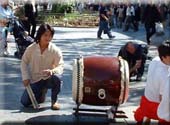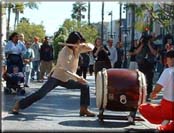
"Tai" in Japanese means great, "ko" means beat, but at times may mean heart or inspiration. Taiko has been an integral part of Japanese society for thousands of years. It has played important roles in culture, religion, history and in common daily life. The Taiko of ancient times was utilized by the samurai in old court traditions and by brave warriors in times of war to instill courage in the ranks and fear in the enemy. Priests used the drum to conduct religious activities and to dispel evil spirits. The commoners used the Taiko for communication between villages, protection, and prayers for rain, as well as for celebration after a bountiful harvest. Taiko can easily be interpreted as the heartbeat of Japanese culture.

Zendeko originated as a Sunday school activity where youths were taught basic matsuri (festival) rhythms. A year later, the world famous Taiko group Ondekoza came to Los Angeles for their tour of the United States. Needing rehearsal area, the members of Ondekoza began their rigorous training at Zenshuji Soto Mission. The two groups befriended each other and it was shortly after that, Zendeko had the privilege to train with this professional group. Zendeko's character subsequently changed from the matsuri to the more theatrical style of Japanese folk music. Before long, the group was invited to perform with Ondekoza at local venues. A few selected members later accompanied Ondekoza abroad. Zendeko has continued to train and practice the teaching of their mentors, passing on tradition and the performing arts to a new generation of young adults. Today Zendeko continues to evolve and grow. The group strives to create original pieces with their own stories and forming new traditions to be passed on.